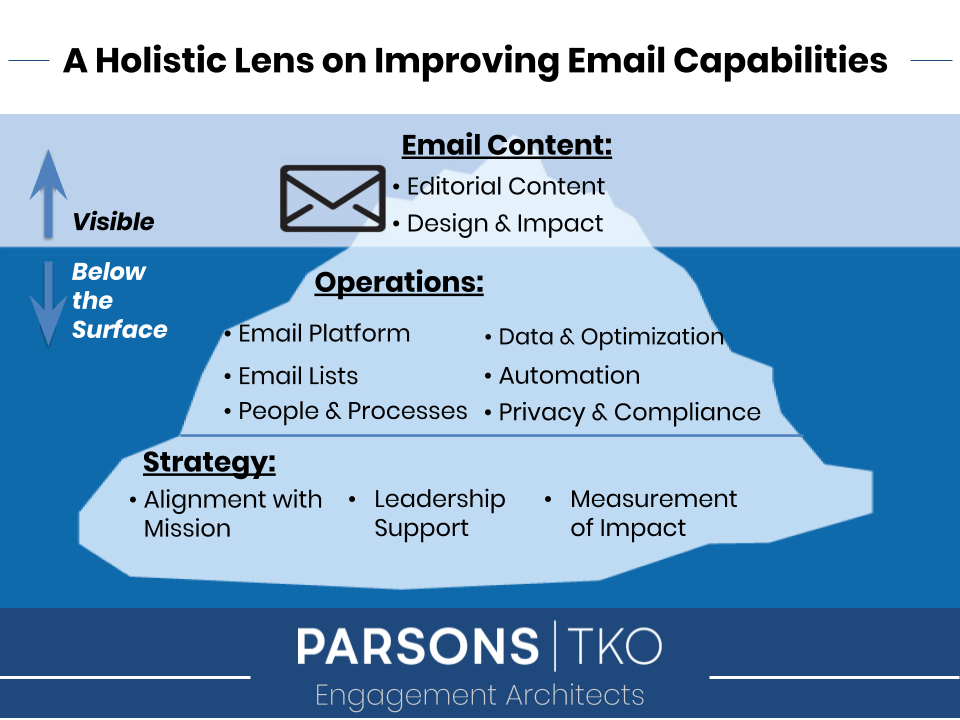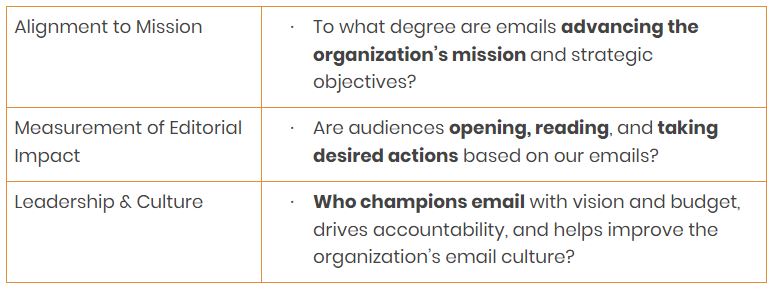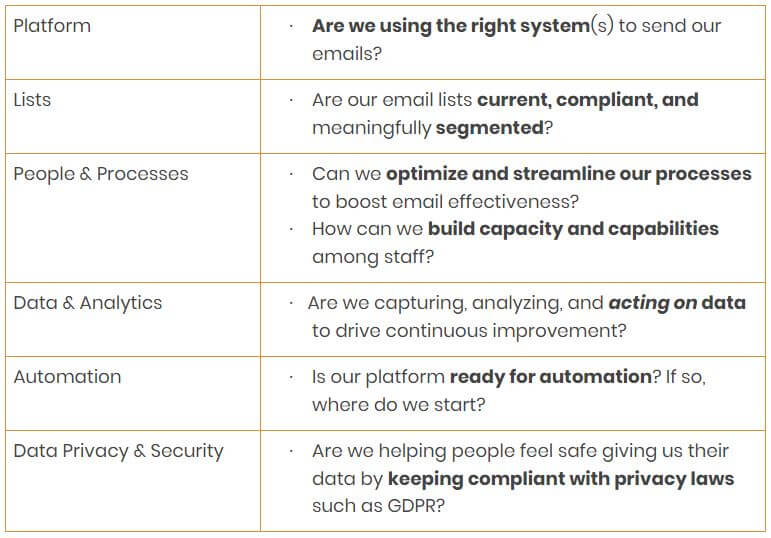Thanks to the ingenuity of tech entrepreneurs, there’s no shortage of ways to stay in touch with your supporters and stakeholders in 2020. Yet, despite the wealth of platforms available to all of us, email remains the best, most reliable platform to expand and deepen engagement with those who care about your mission. Indeed, we even go so far as to say that your email list (and the data it generates about individual audience members) is likely your organization’s most valuable asset.
Why, then, do most mission-driven organizations struggle to maximize the value of their email lists?
Because they don’t ask the right questions about how to improve.
I assure you that it’s possible to leverage existing strengths to drive deeper engagement with your audiences through email, no matter how advanced your email practices are today. To do this, however, requires most organizations to think more holistically about their email operations than current structures and cultures encourage.
The (typical) status quo: a series of isolated email improvements that miss the bigger picture
One big reason why so many groups haven’t optimized their email performance is the narrow, atomized way in which they typically seek out improvements.
For instance: let’s say your team wants to develop a simple welcome automation that triggers as soon as someone signs up for the email newsletter. Good call – it’s one of the most useful things you can do to maximize your impact with limited time and resources. But, consider a few questions…
- Does your email platform allow internal teams to easily manage and edit automation sequences without outside vendor support?
- Who are the audiences for your email welcome series, and what specific actions do you want them to take in the immediate future?
- Are you capturing key data about individual audience members’ engagement with email, and storing it in a single “source of truth” location such as a CRM?
Likewise: perhaps you’re considering a new, visually striking email newsletter template? A user-friendly design is certainly a worthy aspiration. But…
- Do you have meaningful data about the current template that will make the new design more effective?
- Are there any significant limitations in your email platform that will limit the ability to make desired technical changes?
- Do you have clear objectives for the emails? How are you tracking how well they meet those objectives?
As you can see, it’s often dangerous to focus on only one area without an awareness of the interconnections and dependencies at play.
There’s a better way to improve your emails
Of course I’m not saying you shouldn’t focus on specific elements of your email operations. For example, you should almost certainly implement automations to increase audience engagement, as well as assess whether or not your current email platform is the right fit for you. However, doing these things in isolation from other elements poses risks. By underestimating the complexity of your current situation, you may very well end up focusing on the wrong problem – and in the process miss unexpected opportunities to save money, improve systems, and streamline your operations.
Instead, take the time and space to assess your email situation holistically.
This means looking beyond editorial content and design, and focusing on all strategic and operational aspects of your email practices. This includes your email platform, your data collection practices, and how your internal teams work together to plan and send emails. You want to balance effort against value, finding the most valuable initiatives that will improve your overall capabilities.

Key questions to guide your holistic email assessment
Adopting a holistic approach, smart organizations will convene stakeholders across internal departments to assess the overall state of email outreach, and to identify opportunities to improve how it supports organizational goals (all that really matters!).
Once you understand the current state of play, it’s possible to create a road map to implement quick wins and plan for long-term improvements. But before you get to this stage, you’ll need to be asking the right questions. With this in mind, here’s a useful starting point to guide your assessment:
Overall Strategy

Email Operations

Editorial Content & Design

I realize that we’re laying out the best-case scenario here. Let’s say the head of your organization just doesn’t care very much about email. Or maybe you’re relatively junior in your organization, and only have ownership over one piece of the email puzzle (very common). Don’t worry – you can still use a holistic lens to improve your approach to email, even when you don’t hold all the purse strings or functional authority. Just by asking the questions above, you can expand awareness of your situation and uncover opportunities for growth.
How ParsonsTKO can help you
Aspects of email outreach typically cut across multiple functions and departments (e.g. communications, fundraising, IT, etc.). This can make it difficult to think and act holistically, even when you know an integrated and comprehensive approach is exactly what’s needed. This is where outside expertise can be valuable. At ParsonsTKO, our structured process for email assessments gathers information from across the organization, convenes the right stakeholders, aligns perspectives, and helps you develop a mission-driven road map that unlocks new capabilities.





